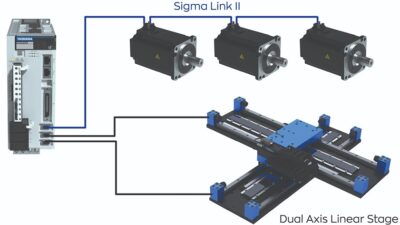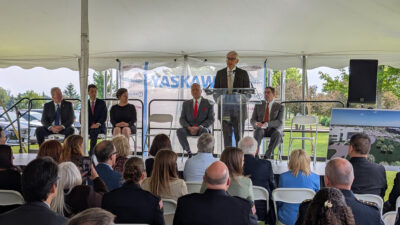Controls and information system personnel are building joint teams that are optimizing manufacturing operations in new ways. Business pressures and technology advances both enable and encourage the collaboration.
|
“Don’t panic when you see an IT person coming. Controls make things happen. Step up and show them how to apply control technology to the business.”
These words, from Invensys Process Systems vice president of strategic ventures Peter Martin, provide good advice on what to do when islands of information converge. They capture what is happening in today’s automation and controls departments as the business side of manufacturing—often represented by Information Technology department personnel—recognizes that plant floor data is highly valuable to the enterprise.
The road to this union of disciplines has not been easy. IT and automation are very different functions. The technologies that govern them evolved from dramatically different places, and by the time computers became commonplace in the manufacturing work environment, working together was not only unwanted, but seemingly unneeded. Then, for a number of reasons—from the spread of open systems to the need to share data—collaboration became a necessity.
The savviest organizations are actively building bridges in the form of cross-functional teams that draw on expertise throughout the enterprise. At Cargill Salt, for example, such teams “have afforded opportunities to develop new technologies that we would otherwise not have had time to pursue,” says Stan Pamel, operations technology manager at Cargill Salt.
Bridges, not islands
Advancing technologies and expanding cultures of openness are facilitating such collaboration. “Companies have begun to recognize that you can’t spend $20 million on demand management and supply chain operations, and then discover that, oops, some things simply don’t work without actual manufacturing data being tied into it as well,” says Sean Robinson, global industry manager, consumer packaged goods, GE Fanuc.
Says Martin, collaboration has advanced to the point today where “no solid reasons remain for maintaining islands of technology or silos of operation. At one plant where we were involved in developing these joint teams, we defined the problems that needed to be solved, then selected people from information management and from automation and controls to be part of the team. The results were remarkable.
“We executed projects that received 100% ROI [return on investment] in mere weeks. When these groups see what they can do together by focusing on the problem, fear and paranoia fade.”
Such problem solving requires communication—which is becoming more common. “IT never used to be present at automation meetings,” observes Peter Zornio, chief strategic officer for Emerson Process Management. “Now they have to be there.”
Technology has played a prominent role in this transition, making IT and manufacturing departments more essential to each other. Primary technology enablers include the spread of open systems, the proliferation of and improvements in Ethernet, and the use of Microsoft Windows.
Technology drivers
“The die was really cast by the transition to open systems,” says Zornio. “Much of the technology, once so different, became largely the same; and working with IT became critical to performing the integration that was needed to achieve the business benefits the enterprise wanted and required.”
Security, Zornio adds, is also a factor: “Systems that are based on commercial technology are potentially more vulnerable to attack, so the two domains have to work together to ensure information flow can happen, but that the path remains secure.”
Brian Oulton, business manager for networks at Rockwell Automation, targets Ethernet as the accelerant for convergence. “Ethernet has become the de facto standard for enterprise networking and has expanded to the I/O and device level. That alone would not cause IT and controls to work together, but coupled with increased business pressures on both groups, these two groups have come to know and understand that they must work together and that they need each other to achieve required business goals.”
“Standardizing on Ethernet,” continues Oulton, “reduces the amount of required training. It means fewer technologies, fewer spare parts, and fewer networks, and affords the opportunity to mix real-time control with business and commercial technologies.”
Voicing agreement is Maryanne Steidinger, discrete industry marketing for the Simatic IT business unit of Siemens Energy & Automation. She says that Ethernet was “an amazing influence,” calling it the enabler that brought the cellular structure together. However, she attributes the convergence of IT and manufacturing domains more to Microsoft Windows.
“The evolution of IT into manufacturing systems began about 10 years ago,” Steidinger says. “In the early days, MES and automation systems didn’t touch IT systems. Each operated in its own silo. Any interfaces manufacturing developed were within its own domain. IT had no need to get involved.”
Windows NT “changed the landscape,” says Steidinger, “opening a way for developing applications that could talk to each other easily. Around the same time, companies like SAP and Oracle began to recognize that plant floor data might be valuable to the entire enterprise.”
Emerson’s Zornio expects wireless technology will further drive IT and automation groups together. “Wireless technology has forced process and IT departments to talk to one another more than ever,” he says.
Take, for example, installing wireless transmitters and a gateway for integration into a DCS—something that can be done simply by automation engineers, Zornio says. “While some controls departments find they can do the installation with no IT permission, many find that company standards require approval from IT. If you want plant-level wireless networking so that an instrument technician can access calibration records, or so a maintenance worker can pull down drawings or operating procedures over an 802.11 network, automation teams will have to work with IT.”
Cargill Salt: Theory into practice
Putting the theory of IT/automation teams into practice takes on substance and form in the recent efforts of Cargill Salt, a business unit of Cargill Inc. About a year ago, the salt products manufacturer launched a multi-site program that joins IT and automation resources together into technology teams, bringing the best and brightest from both domains together to solve problems and optimize operations.
Led by Stan Pamel and supported by the company’s long-standing system integrator, Tec Engineering, a division of Tec Systems Inc., the IT/automation team works with representatives at each facility to accomplish a variety of tasks. Explains Pamel, “My role is to act as facilitator, bringing the teams together. We meet basically through conference calls on a regular basis. Then, two or three times a year, we get together for face-to-face meetings that typically entail presentations or visiting a site that has employed a specific application that will be a benefit to all of us.”
Projects originate at the sites, with technology team members coordinating efforts and compiling activity information. “If we find several sites are dealing with similar issues,” says Pamel, “our group’s resources focus on them. We have at least half a dozen projects for which we have established sub-teams to address these higher priority issues.”
Data on all team activities are collected, with Pamel reporting back results regularly to operations vice presidents.
The system integrator staff, directed by Tec Engineering President and COO Jim Pederson, adds critical resources. Support issues occur on a daily basis, says Pederson.
“Cargill Salt has assigned IT personnel to the technology teams that we interact with day to day,” he explains. “If we get a support call that involves a problem with a system where we need IT help, instead of running into a wall, we find a helping hand, because our people and theirs have been working together for years. We have come to know each other, and the organization.”
By working in areas that traditionally belonged to IT, the technology teams are breaking new ground. In the process, IT has had to recognize that their role is no longer limited to administrative functions and that the applications they are doing here have a bigger impact on the overall operation, Pamel says. Reacting in a real-time world was different for them, adds Pederson: “They were used to one-day response times. In the controls world, if an HMI PC goes down, it can’t wait a day to be fixed, it needs to be addressed in an hour or less.”
Success has not been without challenges. “The logistics of accomplishing these things over a number of sites with the geographical distance involved is difficult, says Pamel. “It takes a lot of energy to keep projects moving forward and resources dedicated to them.”
Activities cannot be add-ons to the daily job, Pederson continues. It’s hard to sit down and be creative, to think into the future, when daily tasks are taking all your time. The key, he stresses—and Pamel agrees—is support. “You must have support from the top, from the vice president of operations on down. And management supports this effort 100%,” Pederson says.
What continues to drive the Cargill teams, and the corporate support thereof, is the fact that the technology teams have generated some concrete, positive end results, including a dramatic reduction in support costs.
“These teams have afforded opportunities to develop new technologies that we would otherwise not have had time to pursue,” says Pamel.
How to build a team…
The complex nature of the tasks tackled by IT/automation teams requires the composition of these cross-functional teams to vary widely. Observes Ashish Gaikwad, global business director for Advanced Solutions, Honeywell Process Solutions: “The team composition depends on the program goals. If the corporate program is focused on standardizing, consolidating, and optimizing IT systems, the team may have one composition. If it is driven by the process efficiency or productivity, it may need more involvement from manufacturing or plant personnel.
“If the drive is to consolidate and streamline business processes and a third-party consultant is involved, then the team composition might be totally different again. Regardless, every team needs a common program charter, a common language, and clear roles and definitions from the beginning.”
GE Fanuc’s Robinson warns: “If you haven’t built your committees with the right mix of skills, you run the risk of decisions based on the knowledge of a limited group of people. The barrier is how to seed the knowledge of each other’s worlds at a technical level across enterprise and manufacturing boundaries.”
A lack of home-grown skills has led some to turn to outside sources. “We see companies turning to consultants to help their cross-functional teams determine what they are looking for,” adds Siemens’ Steidinger. “More and more companies are recognizing their limitations when it comes to today’s complex systems.”
…and ensure success
Cross-functional teams will succeed only if and when the various disciplines understand each other’s language. As a result, training is imperative within the company, but in the long run may also be needed at the institutional level. Faced with such challenges, companies realize that they need to draw on the people knowledge and experience they have.
According to Francois Leclerc, senior manager, product marketing for advanced solutions, Honeywell Process Solutions: “A company needs to be sure that by the time a project is finished, the technology is not obsolete. When you have input from those who are on the cutting edge of both disciplines, that problem is less likely to occur.”
This convergence also brings with it a certain degree of standardization, says Leclerc. “More repeatability and fewer variables mean more experience is shared among departments,” he says.
Most importantly, perhaps, applying control theory to business variables makes control engineers more important than ever; particularly in terms of having a high level of influence on the business.
Says Invensys’ Martin, “The future has never been brighter if controls engineers overcome their fear, realize that they are the intellectual property of their manufacturing operations, and start applying control theories throughout the organization, not just on the plant floor.
“We live in a real-time business world. We cannot behave as if we do not,” insists Martin. “The only way to keep up is to start at the real-time level.”
| Author Information |
| Jeanine Katzel is a contributing editor to Control Engineering. Reach her at [email protected] . |
New technologies facilitate collaboration
Invensys’ recent partnership with enterprise software giant SAP (
“A lot of executives feel they have no visibility into the production process—that they aren’t getting the value from their plant floor systems that they think they should,” says Invensys’ Peter Martin. “Part of the reason is that cost accounting, which resides in the IT world, never makes it to the real-time world.” These kinds of products are making such data more visible.
Seeking tools to facilitate cross-functional relationships and bridge the gap between higher level systems and production, GE Fanuc has developed a real-time service oriented architecture (SOA) that can interact between the domains in one second or less.
According to Greg Millinger, product manager, Workflow, GE Fanuc, “We’re combining an industrial SOA with a business/enterprise-level SOA so that data will be able to pass between them.” The company’s Proficy Workflow software, powered by the new SOA, helps foster this integration and coordinate processes across the enterprise.
Automation/IT convergence has led both Emerson Process Management and Rockwell Automation to partner with Cisco (
John Pritchard, global product marketing manager for Kinetix Integrated Motion Control at Rockwell Automation, describes how such integration techniques will benefit plant floor applications, in this case motion control.
“Moving motion control to Ethernet is not easy,” Pritchard says. “Information on torque, velocity, and position needs to be updated frequently, up to once a millisecond, and deterministically with low jitter (a microsecond or less). Data must be sent equally spaced and highly synchronized. Motion control systems typically have more than one axis, so it’s not enough to establish a point-to-point relationship between a controller and a drive and have it receive the information deterministically a thousand times a second. And some applications have up to 100 axes on one machine. Accomplishing this kind of control typically requires a dedicated network.”
In the second half of 2009, Rockwell plans to introduce a servo controller and drive that uses ODVA’s (
Rockwell Automation and Cisco’s joint venture also has yielded products designed for use by IT and manufacturing personnel alike. Among them is a line of switches that uses the Cisco OS, catalyst feature set, and user interface configuration tools familiar to IT, but also has many features familiar to the manufacturing side. These features include credit card memory for back up and the ability to work with Logix controllers or be incorporated into the Rockwell Automation Integrated Architecture.
Why build IT/automation teams?
Pressure to break down barriers is fostering cross-functional teams in many companies. GE Fanuc’s Sean Robinson, global industry manager for consumer packaged goods, says these teams reside “where understanding what’s worth doing intersects with understanding what’s possible. It is in these groups that you see the ability to redefine the business processes that leverage business knowledge with what technology and tools can actually support.”
Robinson says that “enormous cost-saving and capacity-recovery opportunities” exist in being able to, for example, leverage real-time shop floor status through coordination of material flow. These kinds of things can’t happen unless you have people in the room who understand everything—from the impact of a machine running, or not, through the implications from a material perspective, a logistics perspective, and an availability-of-capacity perspective.
“If you can leverage the same infrastructure or platform to support product innovation strategies—by supporting enterprise information systems around material flows, logistics, and cost management—some strategists say it can have a 2% to 5% net bottom line impact,” adds Robinson.
John Leppiaho, senior Proficy product manager at GE Fanuc, offers an example: “Vendor-managed inventory isn’t an IT task. IT may put in the infrastructure, but the project requires someone who understands the business, the challenges, and the technology. Combined IT/manufacturing knowledge can install sensors to read tank levels and an infrastructure that reports data back so that product can be re-ordered. That encompasses infrastructure, device, and data acquisition technology to develop a solution that enables SAP or Oracle systems to participate right down to the tank level by leveraging an MES system in the middle.”



